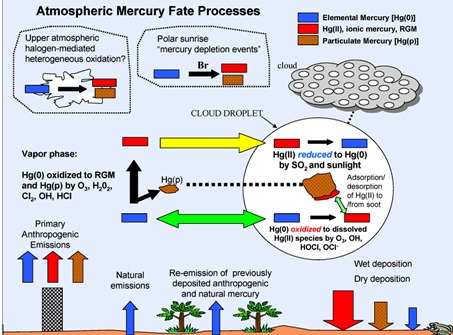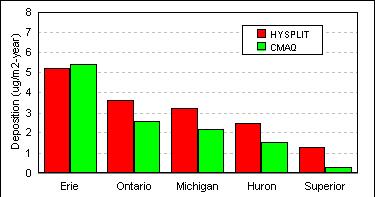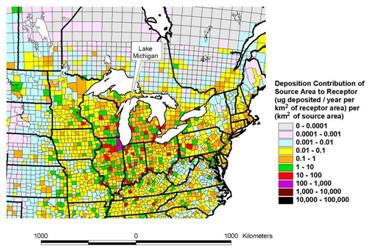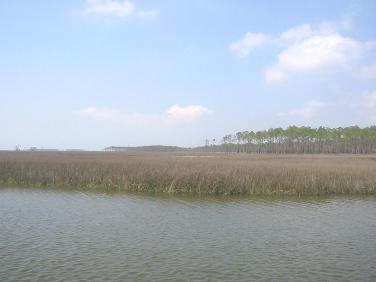New Documents (also included in narrative below):
A new analysis of the source-attribution for 2005 atmospheric mercury deposition to the Great Lakes was carried out in 2015 with funding through the Great Lakes Restoration Initiative (GLRI). This analysis, including a sensitivity analysis examining several different model configurations, and extended model evaluation results, is summarized in a Jan 2016 final report [23]. An initial version of this analysis was presented at the 2015 International Conference for Mercury as a Global Pollutant in Jeju, South Korea [24].
General Overviews:
An overview of mercury in the environment and atmospheric mercury modeling was presented in Oct 2014 to the Air Quality Research Subcommittee (AQRS) of the White House OSTP Committee on Environment, Natural Resources, and Sustainability (CENRS) [1].
Talks summarizing atmospheric mercury and ARL’s mercury activities were presented at ARL’s Lab Review in May 2011 [2] and in a 2012 briefing to NOAA OAR colleagues [3].
A report on Mercury Contamination in the Great Lakes was submitted to Congress in 2007 [4] and summarized in a briefing presentation [5].
A talk summarizing mercury’s public health, ecosystem cycling, bioaccumulation, and atmospheric aspects was given to the NOAA OAR Senior Research Council in Sept 2008 [6].
A talk [7] (with accompanying movie [8]) regarding source-attribution aspects of atmospheric mercury was given at the 2004 USGS Mercury Workshop in Reston, VA. An expanded version of this presentation was given at the MARAMA Mercury Workshop in Cherry Hill, NJ [9].
An overview of mercury emissions, atmospheric fate and transport, and source-receptor relationships was given at a 2006 Niagara Falls meeting organized by the U.S. EPA, the IJC, and the Ontario Ministry of the Environment [10], a 2006 seminar at Frostburg State Univ. [11], and a Dec 2008 National Water Quality Monitoring Council meeting in Reston, VA [12].
An overview of local and regional deposition impacts was given at a Nov 2005 meeting of the Pennsylvania Department of Environmental Protection Mercury Rule Workgroup [13].
An overview of data needs for atmospheric mercury model evaluation was presented at an Oct 2005 meeting in Frostburg MD [14]. An overview presentation regarding mercury fate and transport in the environment was presented to the NOAA OAR Ecosystem Research Program in February 2005 [15].
Model Intercomparisons:
A presentation highlighting the value of model intercomparisons was given at a 2006 EPA-IJC-OMOE meeting; this presentation summarized several examples for mercury, including the study described below, a comparison of HYSPLIT vs. ISC for near-field deposition, and a comparison of HYSPLIT vs. CMAQ for the impact of U.S. coal-fired power plants on the Great Lakes [16].
Simulation of mercury in a European modeling domain has been performed as part of a Mercury Modeling Intercomparison Project organized by MSC-East in Moscow, Russia. The overall project was summarized in a 2005 presentation [17]. Detailed results for Phase II of the project are available as a report [18] and paper [19], and HYSPLIT-specific results are also available [20]. Phase III of the project is described in a report [21] and paper [22].
Great Lakes:
Analysis for 2005:
A third baseline analysis for 2005 was carried out in 2015 with FY13 funding through the Great Lakes Restoration Initiative (GLRI). This analysis, including a sensitivity analysis examining several different model configurations, is summarized in a Jan 2016 final report [23]. An initial version of this analysis was presented at the 2015 International Conference for Mercury as a Global Pollutant in Jeju, South Korea [24].A second baseline analysis for 2005, along with simulations for a range of potential, future emissions scenarios was carried out in 2013-14 through GLRI, and is summarized in an Oct 2014 final report [25]. A sensitivity analysis, carried out with FY11 GLRI funding, examines the influence of key uncertainties on the modeling results and is described in a brief summary [26], a final report [27] and a presentation given at the 2013 International Conference for Mercury as a Global Pollutant in Edinburgh, Scotland [28].
An initial baseline analysis of 2005 mercury deposition to the Great Lakes was first carried out during 2010-2011 under the auspices of GLRI and is described in a brief summary [29], a final report [30] and presentations [31] and [32].
Analysis for 1999:
The 1996 analysis for the Great Lakes (see below) was updated using 1999-2000 emissions inventories [33]. A presentation regarding the transport and deposition of mercury to Lake Michigan was presented to the Indiana Dept of Environmental Management’s Mercury Working Group meeting in April 2005 [34]. A presentation regarding the transport and deposition of mercury to Lake Ontario was presented at the IJC’s Biennial Meeting in Kingston, Ontario, Canada, in June 2005 [35]. The methodology and results for this 1999-2000 analysis is described in detail in the Report to Congress on Great Lakes Mercury Contamination [4].
Analysis for 1996:
A presentation regarding the 1996 atmospheric deposition of mercury to the Great Lakes [36] was given at the IJC-organized symposium An Ecosystem Approach to the Health Effects of Mercury in the Great Lakes Basin. A paper [37] (with Supporting Information [38]) was published in a special issue of the journal Environmental Research dedicated to papers arising from this meeting.
Geographic distribution of atmospheric mercury deposition contributions to Lake Michigan, estimated with the NOAA HYSPLIT-Hg atmospheric mercury fate and transport model. Click here for enlarged version of this figure, as a PDF or a Powerpoint file.
Gulf of Mexico:
A paper describing the isotopic composition of species-specific atmospheric mercury measured at the Grand Bay NERR was published in 2013 [39]. A presentation analyzing an episode of high measured atmospheric reactive gaseous mercury was given at the 10th International Conference on Mercury as a Global Pollutant in Halifax, Nova Scotia, Canada, in 2011 [40]. Overviews of monitoring and modeling atmospheric mercury at the Grand Bay NERR were presented in Pensacola [41] and Sarasota [42], Florida, in 2010, and at Jackson State University, Jackson MS, in 2009 (talk [43] and simulation example [44]).
Source-receptor modeling results for Mobile Bay were presented at the Gulf Coast Mercury Research Collaboration Meeting in Pensacola Florida in May 2006 [45]. A description of the atmospheric mercury monitoring site at the Grand Bay NERR in Mississippi is available[46]. An overview of monitoring and modeling atmospheric mercury in the Gulf of Mexico was presented in Dec 2008 at the Gulf of Mexico Alliance Mercury Workshop in Gulfport, MS [47].
Other Regions:
Chesapeake Bay:
An analysis for the Chesapeake Bay was presented to the NOAA Chesapeake Bay Office [48] and at the 7th International Conference on Mercury as a Global Pollutant (ICMGP) in Slovenia in 2004 [49].
A poster presenting preliminary results from a Summer 2004 atmospheric mercury study in the Chesapeake Bay region was presented at the NADP meeting in Halifax, NS (Sept 2004) [50].
In August 2005, overview talks focusing on the Chesapeake Bay region were given to the Maryland Department of the Environment [51] and the Baltimore City Department of Law [52].
Additional analyses of the Summer 2004 data and plans for a new monitoring program at Beltsville MD were presented at the 8th International Conference on Mercury as a Global Pollutant (ICMGP) in Madison Wisconsin in August 2006 [53]
Lake Champlain:
An analysis for Lake Champlain [54] was presented at a 2003 symposium organized by NOAA Sea Grant in Burlington VT.
Rock Creek Watershed:
Source-receptor modeling results for the Rock Creek Watershed (in the Washington DC area) were presented at a NOAA Atmospheric Mercury meeting in Silver Spring, Nov 2006 [55].
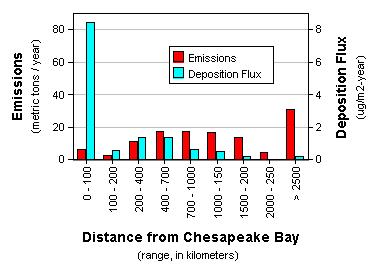
Time Trends:
Potential Impacts of Future Emissions:
A report [56] and presentation [57] were prepared for the CEC, dealing with the potential consequences of future mercury emissions scenarios.
Concentration and Deposition Trends:
A report [58], poster [59], and paper [60] were prepared discussing trends in Mercury Deposition Network data. The report also includes an overview of atmospheric mercury fate/transport and a detailed section examining source-receptor case-studies for mercury wet deposition events associated with individual storms.
Report to Congress:
The NOAA Report to Congress [4] noted above also has an extensive section on mercury trends in the Great Lakes. Available trend data for mercury in biota, sediments, emissions, and deposition are summarized.
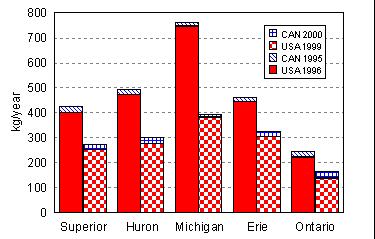
Multimedia Mercury Modeling:
A 2012 paper [61] describes measurement- and model-based estimates of elemental mercury evasion in the Great Lakes Basin.
A 2008 paper [62] describes a multi-media analysis in which mercury deposition trends are estimated from sediment data and atmospheric models. In this case study for the Bay of Fundy region, data from three atmospheric chemistry models (CMAQ, GEOS-Chem, HYSPLIT) and multiple sediment archives (ombrotrophic bog, headwater lake, coastal salt marsh) were utilized. The analysis suggests that deposition attributable to US and Canadian emissions has declined in a recent years, thereby increasing the relative significance of global sources.
A presentation [63] regarding ongoing efforts to link atmospheric mercury models with mercury models in other media was given at the Contaminant Monitoring & Research Workshop Planning for the 2008 Cooperative Monitoring Year (Contaminants Component), Grand Island, New York, March 2007.
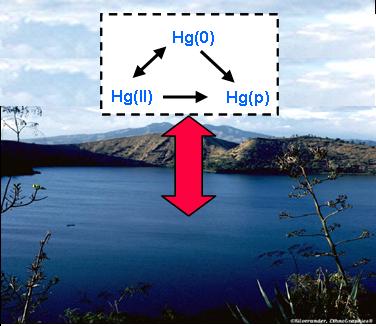
Documents Available for Viewing or Download
General Overviews:
- Mercury Overview / Modeling the Atmospheric Transport and Deposition of Mercury to the Great Lakes (also available as a PowerPoint presentation [13 MB]). Presentation at the Air Quality Research Subcommittee of the White House OSTP Committee on Environment, Natural Resources and Sustainability (CENRS) , Oct 16, 2014, Washington, DC.
- Atmospheric Mercury Research (also available as a PowerPoint presentation [13 MB]). Presentation at the Air Resources Laboratory Review, May 3-5, 2011, Silver Spring, MD.
- Mercury Modeling 101 (also available as a PowerPoint presentation [11 MB]). Presentation at Air Resources Laboratory 101, June 2012, Silver Spring, MD.
- NOAA Report to Congress on Great Lakes Mercury Contamination. Authors: Mark Cohen, Roland Draxler, and Richard Artz. Submitted to Congress on May 14, 2007. The report focuses on two areas: (a) the fate and transport of atmospheric mercury, including an analysis of the atmospheric transport and deposition of U.S. and Canadian anthropogenic mercury emissions to the Great Lakes using the NOAA HYSPLIT-Hg atmospheric mercury model; and (b) data regarding trends in Great Lakes mercury contamination, including trends in mercury air emissions and deposition, and in mercury concentrations in sediments, fish, and other biota.
- The Atmospheric Deposition of Mercury to the Great Lakes (also available as a PowerPoint presentation [10 MB]). Presentation to Congressman Mark Kirk (R-IL) summarizing the Report to Congress on Great Lakes Mercury Contamination, June 12, 2007, Washington D.C.
- Mercury in the Environment: Where Does the Mercury in Fish Come From? (PowerPoint presentation* [32 MB]). Presentation at the NOAA OAR Senior Research Council Meeting, Sept 23, 2008, Silver Spring, MD.
- Source-Apportionment for Mercury Deposition: Where Does the Mercury in Mercury Deposition Come From? (also available as a PowerPoint presentation [11 MB]). Presentation at the USGS Mercury Workshop, August 17-18, 2004, Reston, Virginia.
- Movie Showing Variations in Daily Deposition Flux for a Hypothetical Emissions Source of Reactive Gaseous Mercury, Accompanying “Source-Apportionment for Mercury Deposition: Where Does the Mercury in Mercury Deposition Come From?” (also available as a PowerPoint presentation [9 MB]). Presented at the USGS Mercury Workshop, August 17-18, 2004, Reston, Virginia.
- Source-Apportionment for Mercury Deposition: Where Does the Mercury in Mercury Deposition Come From? (also available as a PowerPoint presentation [11 MB]). Presentation at the MARAMA Mercury Workshop, September 13-14, 2004, Cherry Hill, NJ.
- Atmospheric Mercury: Emissions, Transport/Fate, Source-Receptor Relationships (also available as a PowerPoint file [15 MB]). Presentation at the Collaborative Meeting on Modeling Mercury in Freshwater Environments, organized by IJC, EPA, and the Ontario Ministry of the Environment. Niagara Falls, NY, January 19-20, 2006. General overview of atmospheric mercury modeling, including current challenges faced, and detailed results for Lake Erie. Also includes a discussion of global anthropogenic emissions, natural emissions, and re-emissions, and a comparison of emissions in the U.S., Canada, and China.
- Atmospheric Mercury: Emissions, Transport/Fate, Source-Receptor Relationships (also available as a PowerPoint file [35 MB]). Presentation at the Appalachian Laboratory, University of Maryland Center for Environmental Science, Frostburg State University, April 27, 2006
- Atmospheric Mercury Monitoring and Modeling Programs of the NOAA Air Resources Laboratory (PowerPoint presentation* [17 MB]). Presentation at the National Water Quality Monitoring Council Meeting, Dec 10, 2008, USGS, Reston, VA.
- Local and Regional Deposition Impacts of Atmospheric Mercury Emissions (also available as a PowerPoint file [26 MB]). Presentation to the Mercury Rule Workgroup, Pennsylvania Department of Environmental Protection, Harrisburg, PA, November 18, 2005. General overview of atmospheric mercury modeling, and includes discussion of plume chemistry, and the potential importance of local and regional impacts of mercury emissions.
- Modeling the Atmospheric Transport and Deposition of Mercury (also available as a PowerPoint file [13 MB]). Presentation at “Mercury in Maryland” Meeting, Appalachian Lab, Univ. of Maryland Center for Environmental Science, Frostburg MD, Nov 2-3, 2005. General overview of atmospheric mercury modeling, and includes discussion of the relative merits of different types of ambient measurements for use in model evaluation.
- Opportunities for Mercury Collaboration between the Air Resources Laboratory and the Ecosystem Research Program(also available as a PowerPoint presentation [29 MB]). Presentation to the NOAA Ecosystem Research Program, Feb 16, 2005, Silver Spring, MD.
Model Intercomparisons:
- Atmospheric Mercury Model Intercomparisons (also available as a PowerPoint file [10 MB]). Presentation at the Collaborative Meeting on Modeling Mercury in Freshwater Environments, organized by IJC, EPA, and the Ontario Ministry of the Environment. Niagara Falls, NY, January 19-20, 2006. Discusses the importance of model intercomparisons, and gives examples of HYSPLIT-Hg results compared to many other models, including CMAQ and ISC.
- EMEP Intercomparison Study of Numerical Models for Long-Range Atmospheric Transport of Mercury (also available as aPowerPoint file [2 MB]). Presentation at the EMEP/TFMM Workshop on the Review of the MSC-E Models on HMs and POPs, Oct 13-14, 2005, Moscow, Russia. Summary of Phases I, II, and III of the Mercury Modeling Intercomparison Project.
- Intercomparison Study of Numerical Models for Long-Range Atmospheric Transport of Mercury. Stage II. . Ryaboshapko, A., R. Artz, O. Bullock, J. Christensen, M. Cohen, A. Dastoor, D. Davignon, R. Draxler, R. Ebinghaus, L. Ilyin, J. Mumthe, G. Petersen, D. Syrakov. Meteorological Synthesizing Centre – East, Cooperative Programme for Monitoring and Evaulation of the Long-Range Transmission of Air Pollutants in Europe. MSC-East: Moscow, Russia, 2003.
- Intercomparison study of atmospheric mercury models: 1. Comparison of models with short-term measurements. Ryaboshapko et al. (2007). Science of the Total Environment 376, 228-240.
- HYSPLIT Modeling in Phase II of the EMEP Mercury Modeling Intercomparison Study (also available as a PowerPoint presentation [4 MB]). Presentation at the Expert Meeting on Mercury Model Comparison, MSC-East, Moscow, Russia, April 15-16, 2003.
- Intercomparison Study of Numerical Models for Long Range Atmospheric Transport of Mercury. Stage III. Comparison of Modelling Results with Long-Term Observations and Comparison of Calculated Items of Regional Balances. Ryaboshapko, A., Artz, R., Bullock, R., Christensen, J., Cohen, M., Draxler, R., Ilyin, I., Munthe, J., Pacyna, J., Petersen, G., Syrakov, D., Travnikov, O. Meteorological Synthesizing Centre – East, Moscow, Russia, 2005.
- Intercomparison study of atmospheric mercury models: 2. Modelling results vs. long-term observations and comparison of country deposition budgets. Ryaboshapko et al. (2007). Science of the Total Environment 377, 319-333.
Great Lakes:
- Modeling Atmospheric Mercury Deposition to the Great Lakes: Updated Analysis. . Final Report for work conducted with FY2013 funding from the Great Lakes Restoration Initiative. M. Cohen, NOAA Air Resources Laboratory, College Park, MD. Jan 11, 2016. 80 pages.
- Modeling the Atmospheric Transport and Deposition of Mercury to the Great Lakes (also available as a PowerPoint presentation [10 MB]). Presented at the 12th International Conference on Mercury as a Global Pollutant, June 18, 2015, Jeju, South Korea.
- Modeling Atmospheric Mercury Deposition to the Great Lakes: Projected Consequences of Alternative Future Emissions Scenarios. . Final Report for work conducted with FY2012 funding from the Great Lakes Restoration Initiative. M. Cohen, R. Draxler, R. Artz, NOAA Air Resources Laboratory, Silver Spring, MD. Oct 9, 2014. 194 pages.
- Executive Summary (only) from Modeling Atmospheric Mercury Deposition to the Great Lakes: Examination of the Influence of Variations in Model Inputs, Parameters, and Algorithms on Model Results. Executive Summary from Final Report for work conducted with FY2011 funding from the Great Lakes Restoration Initiative. M. Cohen, R. Draxler, R. Artz, NOAA Air Resources Laboratory, Silver Spring, MD. June 30, 2013.
- Modeling Atmospheric Mercury Deposition to the Great Lakes: Examination of the Influence of Variations in Model Inputs, Parameters, and Algorithms on Model Results. Final Report for work conducted with FY2011 funding from the Great Lakes Restoration Initiative. M. Cohen, R. Draxler, R. Artz, NOAA Air Resources Laboratory, Silver Spring, MD. June 30, 2013. 157 pages.
- Modeling the Atmospheric Transport and Deposition of Mercury to the Great Lakes (also available as a PowerPoint presentation [38 MB]). Presented at the 11th International Conference on Mercury as a Global Pollutant, July 28 – Aug 2, 2013, Edinburgh, Scotland.
- NOAA ARL Modeling Shows Large Contribution of Mercury to Great Lakes from Nearby Sources. Summary of the report below.
- Modeling Atmospheric Mercury Deposition to the Great Lakes. Final Report for work conducted with FY2010 funding from the Great Lakes Restoration Initiative. M. Cohen, R. Draxler, R. Artz, NOAA Air Resources Laboratory, Silver Spring, MD. Dec 16, 2011. 160 pages.
- Modeling the Atmospheric Transport and Deposition of Mercury to the Great Lakes (also available as a PowerPoint presentation [39 MB]). NOAA Air Resources Laboratory Seminar, February 7, 2013, NCWCP, College Park MD, Feb 7, 2013.
- Modeling the Atmospheric Deposition of Mercury to the Great Lakes (work funded through the Great Lakes Restoration Initiative), (also available as a PowerPoint presentation [16 MB]). Presentation to the International Joint Commissions’s International Air Quality Advisory Board, Washington, D.C., April 25, 2012.
- The Atmospheric Transport and Deposition of Mercury to the Great Lakes (1999 updates) (also available as aPowerPoint presentation [10 MB]). Information prepared for the IJC Air Quality Advisory Board, April 16, 2004.
- Source-attribution for atmospheric mercury deposition: Where does the mercury in mercury deposition come from? (also available as a PowerPoint presentation [7 MB]) Presentation to the Mercury Working Group, Office of Air Quality, Indiana Department of Environmental Management, via speakerphone, April 21, 2005. General overview of atmospheric mercury modeling and source-receptor relationships. Also includes detailed results for Lake Michigan.
- Modeling the Atmospheric Transport and Deposition of Mercury (also available as a PowerPoint presentation [10 MB]). Presentation at the IJC Biennial Meeting, June 9, 2005, Kingston, Ontario. General overview of atmospheric mercury modeling, including discussion of challenges faced. Also includes detailed results for Lake Ontario.
- The Atmospheric Deposition of Mercury to the Great Lakes (also available as a PowerPoint presentation [11 MB]). Presentation at An Ecosystem Approach to the Health Effects of Mercury in the Great Lakes Basin February 26-27, 2003, Windsor, Ontario.
- Modeling the Atmospheric Transport and Deposition of Mercury to the Great Lakes. Cohen, M., Artz, R., Draxler, R., Miller, P., Poissant, L., Niemi, D., Ratte, D., Deslauriers, M., Duval, R., Laurin, R., Slotnick, J., Nettesheim, T., and McDonald, J. (2004). Environmental Research 95(3), 247-265.
- Supplementary Information for: Modeling the Atmospheric Transport and Deposition of Mercury to the Great Lakes. Cohen, M., Artz, R., Draxler, R., Miller, P., Poissant, L., Niemi, D., Ratte, D., Deslauriers, M., Duval, R., Laurin, R., Slotnick, J., Nettesheim, T., and McDonald, J. (2004). Environmental Research 95(3), 247-265.
Gulf of Mexico Region:
- Isotopic Composition of Species-Specific Atmospheric Hg in a Coastal Environment. Rolison,J.M., W.M.Landing, W.Luke, M.Cohen, V.J.M.Salters (2013). Chemical Geology 336, 37-49.
- Evaluating the HYSPLIT-Hg Atmospheric Mercury Model Using Ambient Monitoring Data (also available as a PowerPoint presentation [12 MB]). Presented at the 10th International Conference on Mercury as a Global Pollutant, July 23-29, 2011, Halifax, Nova Scotia, Canada.
- Atmospheric Mercury Measurements and Modeling at the Grand Bay NERR (also available as a PowerPoint presentation [8 MB]). Presented at the Gulf of Mexico Alliance, Mercury Forum, May 10-12, 2010, Mote Marine Lab, Sarasota, FL.
- Atmospheric Mercury Measurements and Modeling at the Grand Bay NERR (also available as a PowerPoint presentation [18 MB]). Presented at a regional Mercury Measurements Meeting, January 13–15, 2010, University of West Florida, Pensacola, FL.
- Simulations of Atmospheric Mercury with the NOAA HYSPLIT Model (also available as a PowerPoint presentation [9 MB]). Presented at The Symposium on Atmospheric Modeling and Application of GIS and Scientific Visualization Technologies for Risk Assessment, July 30-31, 2009, Jackson State University, Jackson, MS.
- Example Simulation with the NOAA HYSPLIT Model (also available as a PowerPoint presentation [7 MB]). Model-predicted mercury deposition (wet + dry) in the vicinity of one example Hg source for a 3 day period in April 2008. Presented at The Symposium on Atmospheric Modeling and Application of GIS and Scientific Visualization Technologies for Risk Assessment, July 30-31, 2009, Jackson State University, Jackson, MS.
- Where Does the Mercury in Atmospheric Mercury Deposition Come From? (PowerPoint presentation [15 MB]). A summary of atmospheric mercury monitoring and modeling activities in the Gulf of Mexico region, presented at the Gulf of Mexico Alliance Mercury Workshop, December 2-4, 2008, in Gulfport, Mississippi. Unlike most other presentations on this web page, this document is not available as a PDF but is only available as a PowerPoint 1997-2003 presentation (.ppt). This is because certain important animation features of the presentation could not be readily represented in a PDF file. For users that do not have PowerPoint installed on their computers, Microsoft (MS) offers a free PowerPoint Reader that can be downloaded from the MS website.
- Atmospheric Mercury Modeling at the NOAA Air Resources Laboratory using the HYSPLIT-Hg Model (also available as aPowerPoint file [11 MB]). Presentation at the Gulf Coast Mercury Research Collaboration Meeting, in Pensacola FL, May 18-19, 2006. Overview of HYSPLIT-Hg modeling and source-receptor results for Mobile Bay.
- NOAA’s Atmospheric Mercury Monitoring in the Gulf of Mexico Region (also available as a PowerPoint file [4 MB]). A summary of activities related to the new atmospheric mercury monitoring site at the Grand Bay NERR in Mississippi.
Other Regions:
- Modeling the Fate and Transport of Atmospheric Mercury in the Chesapeake Bay Region (also available as a PowerPoint presentation [11 MB]). Presentation at NOAA Chesapeake Bay Office, May 17, 2004, Annapolis, MD.
- Modeling the Transport and Deposition of Atmospheric Mercury to the Great Lakes (and the Chesapeake Bay) (also available as a PowerPoint presentation [11 MB]). Presentation at the 7th International Conference on Mercury as a Global Pollutant (ICMGP), Llubljana, Slovenia, June 27-July 2, 2004.
- Atmospheric Mercury in the Chesapeake Bay Region: A Measurement and Modeling Study (also available as a PowerPoint file [7 MB]). Poster presented at the NADP Meeting, Halifax, NS, Sept, 2004. Includes preliminary results for mercury measurements collected Summer 2004 at two sites on the Eastern Shore of the Chesapeake Bay.
- Modeling the Atmospheric Transport and Deposition of Mercury (also available as a PowerPoint file [24 MB]). Presentation to the Maryland Department of the Environment, Aug 25, 2005. General overview of atmospheric mercury modeling, including results for Deep Creek Lake.
- Modeling the Atmospheric Transport and Deposition of Mercury (also available as a PowerPoint file [26 MB]). Presentation for Baltimore City Dept of Law, Aug 25, 2005. General overview of atmospheric mercury modeling, including discussion of relative importance of local, regional, continental, and global sources.
- Simulating the Atmospheric Fate and Transport of Mercury using the NOAA HYSPLIT Model (also available as aPowerPoint file [19 MB]). Presentation at the 8th International Conference on Mercury as a Global Pollutant, Madison Wisconsin, August 2006. Analysis of Summer 2004 ambient Hg measuurements at Oxford, MD, and discussion of new monitoring site plans at Grand Bay NERR, MS and Beltsville MD.
- Modeling the Atmospheric Deposition of Mercury to Lake Champlain (from Anthropogenic Sources in the U.S. and Canada) (also available as a PowerPoint presentation [11 MB]). Presentation at the Workshop on Coordination of Atmospheric Deposition Research in the Lake Champlain Basin, June 5-6, 2003, Burlington, Vermont.
- Simulating the Atmospheric Fate and Transport of Mercury using the NOAA HYSPLIT Model (also available as aPowerPoint file [5 MB]). Presentation at the NOAA Atmospheric Mercury Meeting November 14-15, 2006, Silver Spring MD. Includes overview of current modeling activities and results for Rock Creek MD watershed.
Time Trends:
- Atmospheric Mercury Deposition Impacts of Future Electric Power Generation. Final Report. Mark Cohen, NOAA Air Resources Laboratory, Silver Spring, MD. Project Manager and Co-Investigator: Paul J. Miller, Program Coordinator, Air Quality, Commission for Environmental Cooperation (CEC), Montreal, Quebec, Canada. Prepared for the CEC, December 8, 2003.
- Atmospheric Mercury Deposition Impacts of Future Electric Power Generation (also available as a PowerPoint presentation [9 MB]). Presentation at Mercury in the Great Lakes Region, Sponsored by the Commission for Environmental Cooperation’s Environment, Economy and Trade and Pollutants and Health Programs in cooperation with the Binational Toxic Strategy, December 17th, 2003, Chicago, IL.
- Mercury in the Environment and Patterns of Mercury Deposition from the NADP/MDN Mercury Deposition Network. Final Report to USEPA Clean Air Markets Division, January 2007. Authors: Tom Butler and Gene Likens (Institute of Ecosystem Studies), Mark Cohen (NOAA Air Resources Lab), and Francoise Vermeylen (Cornell University).
- Mercury at MDN sites, 1998-2005: Declines in the Northeast, No Change in the Southeast (also available as a PowerPoint file [2 MB]). Authors: Tom Butler, Gene Likens, Mark Cohen, Francoise Vermeylen, David Schmeltz and Richard Artz. Poster presented by Tom Butler at the National Atmospheric Deposition Program 29th Annual Technical Meeting – NADP 2006: Effects of Deposition in Coastal and Urban Environments. Norfolk, Virginia, 24-26 October 2006.
- Regional precipitation mercury trends in the eastern USA, 1998-2005: Declines in the Northeast and Midwest, no trend in the Southeast. T. Butler, M. Cohen, F. Vermeylen, G. Likens, D. Schmeltz, R Artz (2008). Atmospheric Environment 42, 1582-1592.
Multimedia Mercury Modeling:
- A synthesis of rates and controls on elemental mercury evasion in the Great Lakes Basin. Joseph S. Denkenberger, Charles T. Driscoll, Brian A. Branfireun, Chris S. Eckley, Mark Cohen, Pranesh Selvendiran (2012). Environmental Pollution 161291-298.
- Reconciling models and measurements to assess trends in atmospheric mercury deposition. E. Sunderland, M. Cohen, N. Selin, G. Chmura (2008). Environmental Pollution 156 526-535.
- Atmospheric Fate and Transport of Mercury (also available as a PowerPoint file [8 MB]). Presentation at the Lake Ontario Contaminant Monitoring & Research Workshop Planning for the 2008 Cooperative Monitoring Year (Contaminants Component), Grand Island, New York, March 27 & 28, 2007. Includes discussions of: (a) ongoing efforts to link atmospheric mercury models with mercury models in other media; (b) atmospheric modeling needs and goals; (c) results for Lake Ontario.


